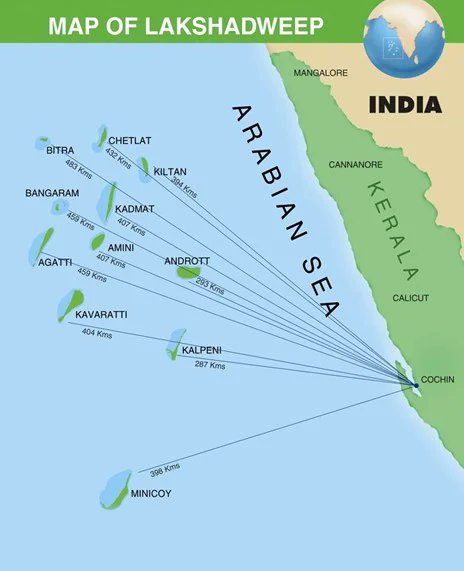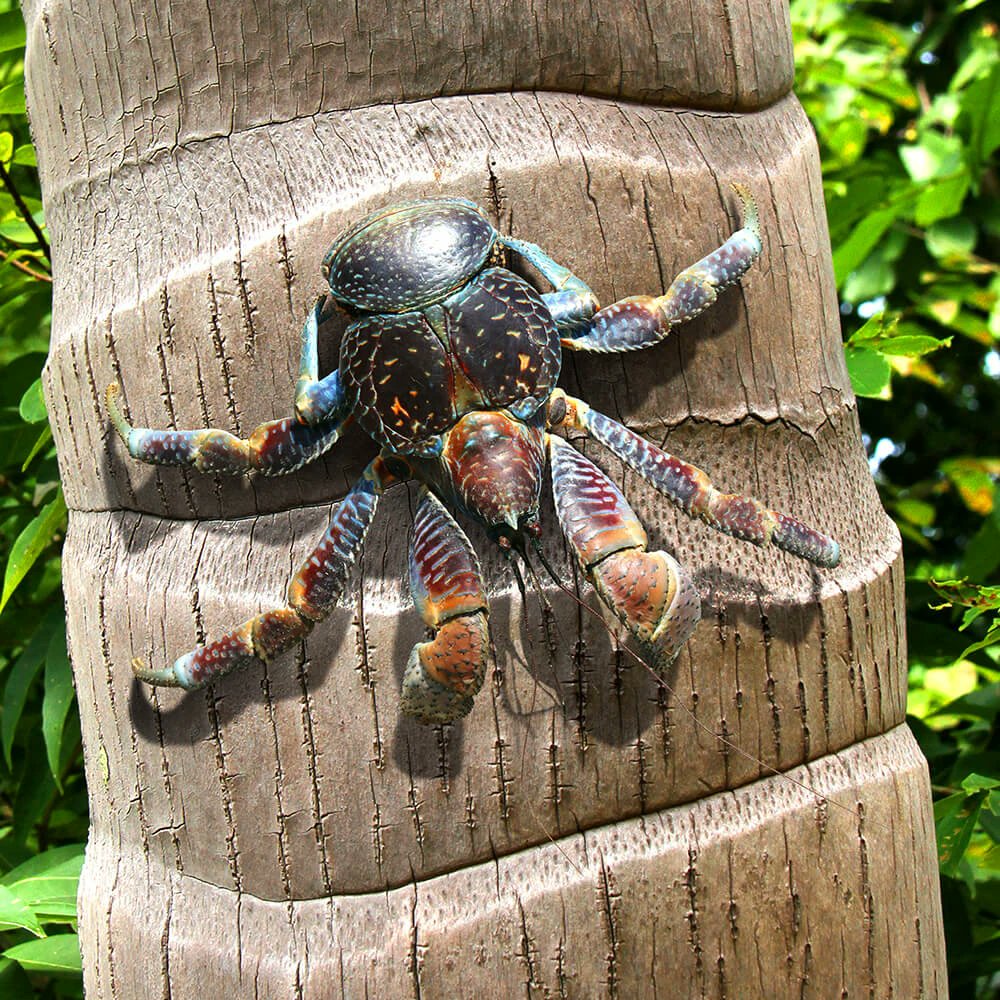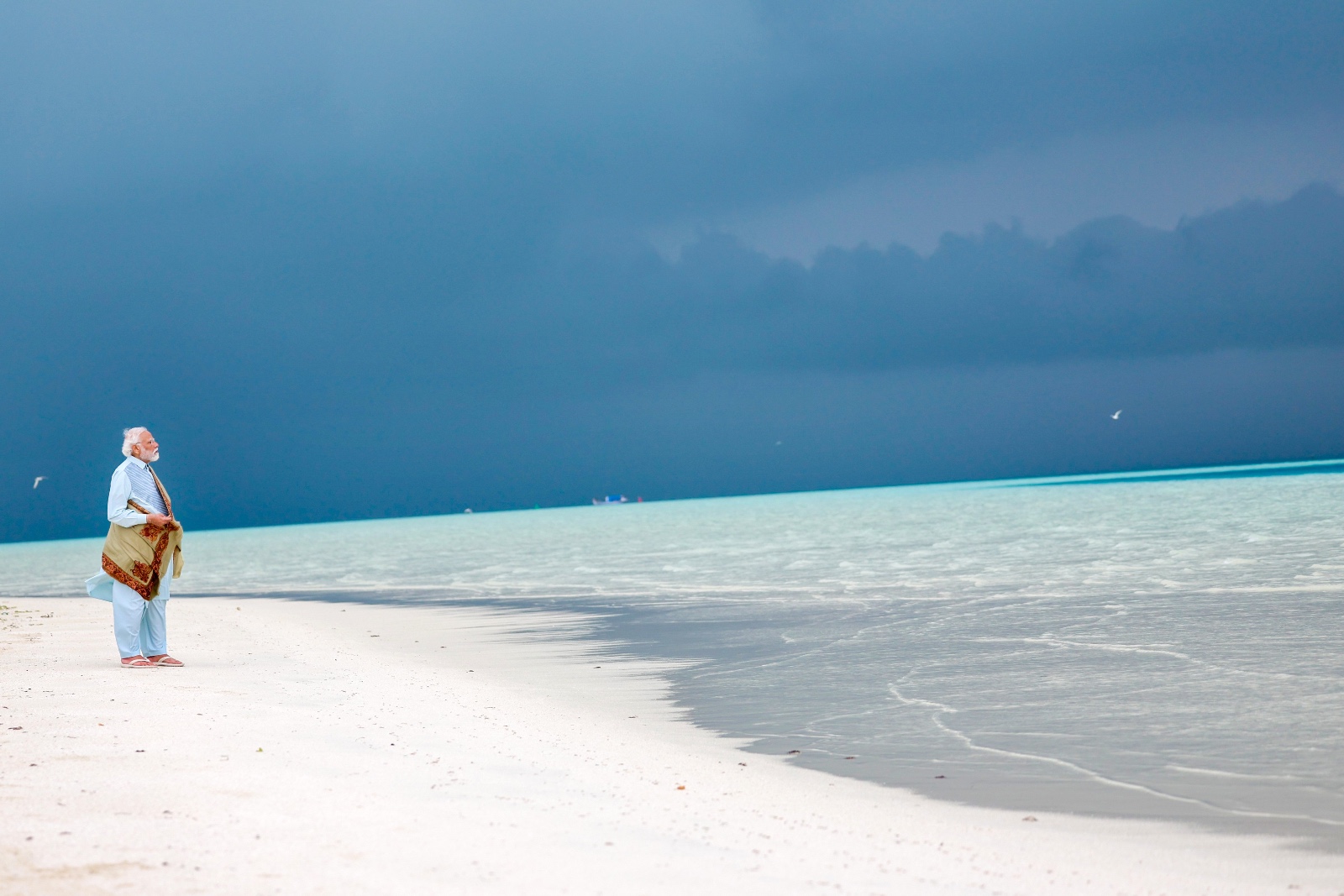Lakshadweep is a union territory of India, consisting of 36 islands scattered over an area of 78,000 square km in the Arabian Sea.
The name Lakshadweep means “one lakh islands” in Malayalam and Sanskrit, though only 10 of them are inhabited by humans.
The islands are known for their pristine beaches, rich marine life, and diverse culture. In this article, we will explore the history, geography, culture, and tourism of Lakshadweep.
History of Lakshadweep
Ancient Origins and Influences
- Buddhist Connections: Buddhist Jataka stories suggest Buddha’s visit in the sixth century BCE.
- Mentioned by Greek geographer Ptolemy in the second century CE as the Laccadive Islands.
Cultural and Religious Evolution
- Diverse Influences: Impact of various cultures and religions like Hinduism, Buddhism, Jainism, Islam, and Christianity.
- Arrival of the first Muslim settlers in the seventh century, leading to Islam becoming the dominant religion by the 14th century.
Dynastic Rulers and External Encounters
- Local Dynasties: Rule by dynasties like Cheras, Cholas, Kolathiris, and Arakkals marked by conflicts among themselves and with the Portuguese, who arrived in the 16th century.
- Colonial Rule: Control shifted to Tipu Sultan of Mysore in the 18th century after the Third Anglo-Mysore War in 1799.
- Subsequent administration by the British as part of the Madras Presidency until 1956.
British Annexation and Union Territory Status
- Colonial Transition: The islands were ceded to the British after Tipu Sultan’s defeat.
- Administered as part of the Madras Presidency until reorganized as a union territory of India in 1956.
Geography of Lakshadweep
Lakshadweep is an archipelago of coral atolls, which are ring-shaped reefs that enclose a lagoon. The islands are divided into three groups: the Amindivi Islands, the Laccadive Islands, and the Minicoy Island.
The largest island is Andrott, which covers an area of 4.9 square km, and the smallest is Bitra, which covers only 0.1 square km. The highest point in Lakshadweep is on Agatti Island, which rises to 10 meters above sea level.

The islands have a tropical climate, with hot and humid weather throughout the year. The average temperature ranges from 25 to 35 degrees Celsius, and the average rainfall is about 1600 mm per year.
The islands are prone to cyclones and storms, especially during the monsoon season from June to November.
Governance Structure in Lakshadweep
Union Territory Framework
- Administrative Model: Lakshadweep operates as a union territory, directly managed by the central government of India.
Administrative Framework
Key Officials
- Administrator Role: Appointed by the President of India, serves as the representative of the central government’s interests.
- District Division: Divided into districts for administrative purposes and efficient governance.
Local Governance Setup
- Panchayati Raj System: Village-level panchayats manage and oversee local affairs.
Representation in Legislation
Parliamentary Representation
- Lok Sabha Seat: Holds one seat in the Lok Sabha (House of the People).
- Rajya Sabha Absence: No representation in the Rajya Sabha (Council of States).
Centralized Administrative Control
Central Oversight
- Central Authority: Central government exercises substantial administrative control and sets major policies.
Legal Framework Adherence
- Application of Laws: Lakshadweep adheres to central laws and regulations governing the union territory.
Development and Welfare Execution
- Initiative Implementation: Execution of central government developmental initiatives and welfare programs.
Unique Governance Dynamics
Geographical Challenges
- Geographic Complexity: Governance faces complexities due to the dispersed and isolated nature of the islands.
Biodiversity: Flora and Fauna of Lakshadweep

Lakshadweep is an archipelago of coral atolls, which are ring-shaped reefs that enclose a lagoon.
The islands are home to a rich biodiversity, with over 600 species of marine fishes, 78 species of corals, 82 species of seaweeds, 52 species of crabs, 101 species of birds, and 12 species of mammals.
Some of the endangered and endemic species found in Lakshadweep are the leatherback turtle, the hawksbill turtle, the green turtle, the dugong, the coconut crab, the Lakshadweep parakeet, and the Lakshadweep flying fox.
The flora of the islands include banana, vazha, colocassia, chambu, drumstick, breadfruit, wild almond, and coconut, which are grown extensively. Some of the shrub jungles plant like kanni, punna, chavok, and cheerani are unevenly grown throughout the island.
Coconut is the only commercial crop of economic importance in Lakshadweep. These are found in different varieties such as Laccadive micro, Laccadive ordinary, green dwarf, etc. Two different varieties of sea grass are seen adjacent to the beaches.
They are known as thalassia hemprichin and cymodocea isoetifolia. They prevent sea erosion and movement of the beach sediments.
Culture of Lakshadweep
Influence and Diversity
- Influenced by various ethnic groups and religions over centuries.
- Majority population follows the Shafi school of Sunni Islam.
- Languages spoken: Malayalam, Jeseri, Mahl, and English.
- Vibrant oral tradition: folk songs, dances, and stories reflecting history and lifestyle.
Cuisine
- Based on coconut, fish, rice, and spices.
- Popular dishes: thoran (dry vegetable dish), kalan (yogurt-based curry), biryani, bonda (fried gram flour snack).
- Production of coconut oil, copra, coir, and fish products.
Festivals and Celebrations
- Celebrations throughout the year: Eid al-Fitr, Eid al-Adha, Milad-un-Nabi, Bakrid, Muharram, and Ramzan.
- Cultural programs, sports competitions, and boat races attract tourists and locals.
Since the last 9 years we have worked to enhance Lakshadweep's progress and our resolve only got stronger! pic.twitter.com/hn0otKPuxC
— Narendra Modi (@narendramodi) January 4, 2024
Traditional Dances
- Parichakali: Men’s dance using wooden swords and shields, reenacting tales of battles.
- Kolkali: Men’s dance in pairs using sticks, moving rhythmically to accompanying songs.
- Lava: Most popular dance in Minicoy, involving rhythmic movements and hand clapping.
- Oppana: Women’s dance during marriages, led by a singer and accompanied by a group of women.
- Others: Dandi, bandiya, fuli, attam, ulakkamuttu, etc., are other dance forms.
Marriage Cultures of Lakshadweep
- Islamic Influence: Majority population adheres to the Shafi school of Sunni Islam.
- Marriages follow Islamic rites and customs.
- Marriage Process: Arranged marriages with parental or elder involvement.
- Groom’s side initiates proposal, fixing date and venue if accepted.
Marriage Ceremony
- Nikah: Official marriage contract performed by a religious authority, with bride and groom declaring consent and groom paying dowry.
- Walima: Reception feast hosted by groom’s side, involving a lavish spread of food and drinks.
- Wedding Celebration:
- Inclusion of Oppana, a dance form performed by women during marriage celebrations, adorning the bride with flowers and jewelry.
Tourism in Lakshadweep
Attractions in Lakshadweep
- Scenic Beauty: Serene beaches, crystal clear waters, and vibrant coral reefs.
- Water Sports: Scuba diving, snorkeling, kayaking, sailing, fishing, and surfing opportunities abound.
- Historical and Religious Sites: Ujra Mosque, Juma Mosque, the Lighthouse, and the Buddhist Archaeological Museum showcase the islands’ history and religious heritage.
For those who wish to embrace the adventurer in them, Lakshadweep has to be on your list.
— Narendra Modi (@narendramodi) January 4, 2024
During my stay, I also tried snorkelling – what an exhilarating experience it was! pic.twitter.com/rikUTGlFN7
Accommodation Options
- Resorts and Hotels: Varied options catering to different budgets and preferences. Well-known options include Bangaram Island Resort, Agatti Island Beach Resort, Kadmat Island Beach Resort, and Minicoy Island Beach Resort.
- Accessibility: Access via luxurious cruise ships offering a comfortable exploration of the archipelago.
Regulation and Tour Packages
- Tourism Department Oversight: Lakshadweep Tourism Department ensures sustainable and eco-friendly tourism practices.
- Tour Packages: Lakshadweep Samudram, Swaying Palm, Marine Wealth Awareness Programme, and Taratashi offer comprehensive packages covering accommodation, transportation, sightseeing, and activities.
- Cultural Showcases: Organized events such as cultural programs, sports competitions, and boat races highlight local culture and heritage.
Economic and Social Impact
- Contributions: Significant contributions to economic development and social welfare. Employment opportunities, income generation, infrastructure development, and environmental conservation efforts.
- Preservation Efforts: Plays a role in preserving and promoting Lakshadweep’s unique identity and diverse culture.
Appeal and Experience
- Nature and Culture Harmony: Unique blend offering a harmonious coexistence of nature and cultural richness.
- Visitor Experience: Appeals to nature lovers, adventure seekers, and culture enthusiasts.
- Hidden Gem: Offers a unique and charming experience, showcasing India’s hidden treasures.
What are some Best Beaches in Lakshadweep?
Lakshadweep is a union territory of India, consisting of 36 islands in the Arabian Sea. The islands are famous for their scenic beauty, serene beaches, crystal clear waters, and coral reefs. Some of the best beaches in Lakshadweep are:
Kavaratti Beach
This is one of the most popular beaches in Lakshadweep, featuring a crystal blue lagoon, lush green vegetation, and sparkling shore. You can enjoy activities like knee boat ride, boating in glass bottom boats, scuba diving, and swimming.
Minicoy Beach
This is one of the prettiest beaches in Lakshadweep, located in the southern part of the archipelago. It has a vintage lighthouse that offers stunning views of the island. You can also try tuna fishing, bird watching, and witnessing some gorgeous sunsets.
Agatti Beach
This is the entryway to Lakshadweep, as it is the only island with an airstrip. It is famed for its sea turtles and beautiful corals. You can indulge in water sports like sailing, scuba diving, angling, and surfing.
Kalpeni Beach
This is one of the most serene beaches in Lakshadweep, with a calm lagoon and a long stretch of white sand. You can relax, take a stroll, or enjoy a picnic on the beach.
Kadmat Beach
This is one of the most secluded beaches in Lakshadweep, ideal for those who want to escape the crowd and enjoy some privacy. It has a narrow strip of land surrounded by water on both sides. You can also explore the marine life and coral reefs by snorkeling or diving.
Bangaram Beach
This is one of the most exotic beaches in Lakshadweep, located on a small island that is uninhabited by humans. It has a turquoise lagoon, a coral reef, and a palm-fringed beach. You can also spot dolphins, turtles, and rays in the water.
Kiltan Beach
This is one of the most unique beaches in Lakshadweep, as it has a rocky shore and a coral reef. It is also rich in history, as it was a trading center for spices and pottery in the past. You can also visit the local village and see the traditional crafts and culture.
Amini Beach
This is one of the most lively beaches in Lakshadweep, as it has a vibrant local community and a bustling market. You can also enjoy scuba diving, snorkeling, and fishing on the beach.
How to Reach Lakshadweep?
Lakshadweep is a union territory of India, consisting of 36 islands in the Arabian Sea. You can reach Lakshadweep by air or by sea from Kochi, Kerala.
By Air
There are regular flights from Kochi to Agatti Island, which is the only island with an airstrip. The flight duration is about 75 minutes, and the fare is around Rs. 10,000 for a round trip. From Agatti, you can take a boat or a helicopter to other islands, such as Kavaratti, Kadmat, and Bangaram. The boat fare is around Rs. 500 to Rs. 1,000, and the helicopter fare is around Rs. 4,000 to Rs. 5,000 per person.
By Sea
Alternatively, you can take a passenger ship from Kochi to Lakshadweep, which takes about 14 to 18 hours depending on the destination. The ships offer different classes of accommodation and facilities, such as A/C deluxe cabins, A/C first class cabins, tourist class, and dormitory. The fare ranges from Rs. 2,000 to Rs. 8,000 per person for a round trip. The ships operate on a fixed schedule, and the booking can be done online or through authorized agents.
You can find more information about how to reach Lakshadweep on this website.
What are some good Hotels and Restaurants in Lakshadweep?
Lakshadweep is a union territory of India, consisting of 36 islands in the Arabian Sea. The islands have a distinctive cuisine, based on coconut, fish, rice, and spices. Some of the good restaurants and Hotels in Lakshadweep are:
Cafe de Saina
This is a fast food restaurant located on Kavaratti Island. It offers a variety of snacks, beverages, and desserts. You can enjoy the cool sea breeze and the lovely ambience while having your meal.
Banjara Dlite By Goldfinch Express
This is an Indian restaurant located on Bangaram Island. It serves delicious dishes like biryani, thoran, kalan, and bonda. You can also try the local specialties like tuna fish and coconut water.
Akshaya Mess and Food Court
This is a budget-friendly restaurant located on Agatti Island. It offers a range of vegetarian and non-vegetarian dishes, such as dosa, idli, paratha, curry, and fry. You can also enjoy the fresh seafood and the coconut milk.
Heavens Treat Beach Restaurant
This is a beachside restaurant located on Kadmat Island. It offers a romantic and relaxing atmosphere, with candlelight dinners and live music. You can savor the exotic dishes like lobster, crab, squid, and prawn.
Al Bharath Restaurant
This is a multi-cuisine restaurant located on Minicoy Island. It offers a variety of dishes, such as Chinese, Continental, and Indian. You can also taste the local delicacies like appam, stew, and halwa.
Z Corner Restaurant
This is a cozy and casual restaurant located on Kalpeni Island. It offers a mix of traditional and modern dishes, such as sambar, rasam, pizza, and burger. You can also enjoy the scenic view of the lagoon and the coral reef.
Coral Beach Resort: This is a fast food restaurant located on Kavaratti Island. It offers a variety of snacks, beverages, and desserts. You can enjoy the cool sea breeze and the lovely ambience while having your meal.
